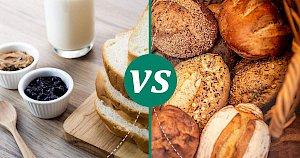Bread vs Toast (Toasted Bread): Nutrition, Calories & Protein Compared


Bread vs Toast
Nutrition Facts
Serving size:
change
5g10g15g20g30g40g50g60g80g100g120g140g160g180g200g220g250g300g350g400g450g500g600g700g800g900g1000g
1oz2oz3oz4oz5oz6oz7oz8oz10oz12oz15oz20oz25oz30oz35oz40oz50oz
Amount Per Serving:
Serving size:
change
5g10g15g20g30g40g50g60g80g100g120g140g160g180g200g220g250g300g350g400g450g500g600g700g800g900g1000g
1oz2oz3oz4oz5oz6oz7oz8oz10oz12oz15oz20oz25oz30oz35oz40oz50oz
Amount Per Serving:
Bread vs Toast 100g Compare
| per 100g | Bread | Toast (toasted bread) |
|---|---|---|
| Calories | 266 | 313 |
| Carbohydrates | 49.42 g | 55.77 g |
| Fat | 3.33 g | 4.27 g |
| Dietary fiber | 2.7 g | 4.7 g |
| Protein | 8.85 g | 12.96 g |
| Water | 36.42 g | 24.23 g |
| Calcium | 144 mg | 165 mg |
| Iron | 3.61 mg | 4.09 mg |
| Magnessium | 23 mg | 59 mg |
| Phosphorus | 0.2 mg | 5.7 mg |
| Potassium | 126 mg | 223 mg |
| Sodium | 490 mg | 601 mg |
| Zink | 0.2 mg | 5.7 mg |
| Vitaminium B1 (Thiamine) | 0.533 mg | 0.439 mg |
| Vitaminium B2 (riboflavin) | 0.243 mg | 0.382 mg |
| Vitaminium B3 (Niacin) | 4.78 mg | 6.25 mg |
| Vitaminium B6 | 0.087 mg | 0.153 mg |
| Vitaminium B9 (Folic acid) | 0.171 mg | 0.1 mg |
| Vitaminium E | 0.22 mg | 0.24 mg |
When it comes to the world of baked goods, few items are as universally loved and versatile as bread. From the crusty baguettes of France to the soft, fluffy white bread of a classic American sandwich, bread plays a central role in meals across the globe. But what happens when you take a slice of bread and introduce it to the heat of a toaster? You get toast, a crispy, golden-brown transformation that feels like a completely different food. While both bread and toast start from the same base, the nutritional changes and taste experience they offer are quite distinct.
A Crunchy Evolution: Bread Turns into Toast
The process of toasting bread not only changes its texture and flavor but also its nutritional profile. When bread is toasted, it undergoes a chemical reaction known as the Maillard reaction, which not only gives it a golden color and crispy texture but also enhances its flavor complexity. However, many people wonder how this transformation affects its health benefits.
At a glance, the nutritional differences between bread and toast might seem minor, but they're worth noting. For instance, toasting bread slightly increases its calorie content - from 266 calories in bread to 313 calories in toast. This is primarily due to the reduction in water content, as toast has only 24.23% water compared to bread's 36.42%. This dehydration process concentrates the toast's other components, such as carbohydrates, which increase from 49.42g in bread to 55.77g in toast.
Interestingly, the process of toasting can actually improve certain nutritional aspects. For example, the fiber content increases from 2.7g in bread to 4.7g in toast, making it a better option for those looking to increase their dietary fiber intake. Additionally, toasting bread boosts its protein content from 8.85g to 12.96g, providing a more substantial protein boost than its untoasted counterpart.
Flavor and Texture: A Sensory Experience
Beyond the numbers, the transformation from bread to toast creates a completely different sensory experience. The crispy texture of toast offers a satisfying crunch that bread alone cannot provide. This texture change, combined with the enhanced flavor from the Maillard reaction, makes toast a beloved choice for breakfast and snacks alike.
However, toast's versatility goes beyond breakfast. It serves as a sturdy base for toppings that might overwhelm fresh bread, from creamy avocado to classic peanut butter and jelly. The slight bitterness introduced by the toasting process can also complement the sweetness of jams or the savoriness of cheese, providing a more complex flavor profile.
Choosing Between Bread and Toast
Ultimately, the choice between bread and toast comes down to personal preference and dietary needs. For those seeking to increase their fiber and protein intake, toast might be the better option. However, it's also important to consider the slightly higher calorie and carbohydrate content that comes with toasting.
For individuals with specific dietary restrictions or health goals, understanding the subtle differences between bread and toast can help make more informed choices. Whether you prefer the soft, chewy texture of fresh bread or the crisp, golden crunch of toast, both have their place in a balanced diet.
In conclusion, while bread and toast start from the same humble beginnings, they offer distinct nutritional profiles and sensory experiences. Whether you're a fan of the classic soft slice of bread or the crispy, flavorful joy of toast, there's no denying the versatile role they play in our diets and our hearts.
Bread 100g
266kcalCalories source
- 75% CARBS.
- 13% PROTEIN
- 11% FAT
Toast (toasted bread) 100g
313kcalCalories source
- 71% CARBS
- 17% PROTEIN
- 12% FAT
Compares of bread
- Bread vs Baguette
- Bread vs Dinner Roll
- Bread vs Dark Bread
- Bread vs Kaiser Roll
- Bread vs Pretzel
- Bread vs Tortilla
- see all compares of bread
Compares of toast
Read also:
- Calories from Bread
- Calories of Sardines
- Calories in Edam cheese
- Almond oil calories per 100g
- Blackberry juice protein per 100g
- How many calories does rum have?
- Calories in a half of smoked sausage
- Calories in whole smoked sausage
- Calories for one, two or more smoked sausage
- How much protein in Gyoza dumplings?
Marcin Piotrowicz
calories-info.com creator
Healthy diet and healthy lifestyle promoter
Add comment